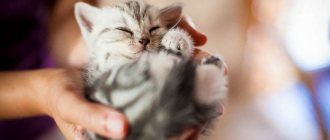Author: GEvpatoriya
30 June 2022 22:00
Community: Animals
Tags: cat veterinary useful articles
13459
1
On average, cats live 13–17 years at home, and 4–5 years in the wild and on the street. The lifespan of each cat is individual, does not depend on gender, is determined at the genetic level and changes under the influence of the environment. Life expectancy is influenced by living conditions, care, and the ability to receive timely help from a veterinarian.
0
Average life expectancy of male cats depending on breed
Different types of cats have different genetic predispositions. Whether a cat belongs to a particular breed largely affects its life expectancy. It has been noticed that animals of oriental breeds have good health, they are more resilient, and therefore live longer than others. But representatives of other cat breeds can also have a fairly long life.
Table: dependence of the average life expectancy of a cat on its breed
| Cat breed name | Life expectancy, years |
| American Shorthair, Siamese, Manx Tailless, Thai | 18‒20 |
| Abyssinian, Maine Coon, Japanese Bobtail, Australian Smoke, Devon Rex, Neva Masquerade, Asian Tabby | 15‒18 |
| Persian, Sphynx, British Shorthair, Bohemian Rex, Yorkie Chocolate, American Bobtail, Cymric, Scottish, Selkirk Rex, Ural Rex | 12‒15 |
| Russian Blue, Exotic Shorthair, Snow Shoe, Bombay | 10‒12 |
Although the average lifespan of cats rarely exceeds twenty years, there are exceptions. Such representatives of the cat family can be called very happy pets.
The oldest cat, Nutmeg, was 32 years old when they decided to euthanize him.
Not every animal is capable of crossing the 20-year mark, even with excellent care. However, it will largely depend on the owners of cats and cats how many years their pet will live in the world.
Factors influencing the life expectancy of cats and kittens
The length of a cat's life span is influenced by various factors, including heredity, proper care, and others.
Heredity
Health, energy, ability to reproduce, and negative character traits can be inherited. The genes inherited by an animal from its ancestors can in some way influence its lifespan. When an animal has good genes and good health from its parents, it has a better chance of living a long life. Before choosing a pet, it is a good idea to find out its pedigree, if any.
A cat's good heredity increases its chance of a long life
This step will help you find out how long the cat can live, how long it will be active, and what possible diseases it inherited.
You need to know that cat breeds bred to participate in exhibitions and competitions do not live long. Their structure and the entire body as a whole will be negatively affected by the influence of selection. These changes are passed on to each next generation.
Proper care
The life span of cats is also greatly influenced by proper care for them. It includes:
- nutritious nutrition: the popular phrase “We are what we eat” can also be applied to animals, since a cat by nature is a predator, it needs high-quality animal proteins, a varied food and a nutritious diet with the addition of essential vitamins and microelements will contribute to the normal development and vitality of the body; You should not overfeed your cat - obesity reduces life expectancy;
Proper care will make a cat long-lived
- systematic examination at a veterinary clinic, timely adoption of preventive measures, vaccination: regular visits to the doctor will help to identify and prevent a dangerous disease in time;
- physical activity of the pet to maintain its shape: it is necessary to create conditions for the cat to play, his active lifestyle, it is necessary to play with the animal more often;
- hygiene in caring for the animal: you need to ensure proper care of the fur, claws, teeth; hygiene procedures help improve the health of the pet;
- care and attention towards the pet.
Sex life
The longevity of cats also depends on such an important factor as sex life. Street cats can experience up to 3 heat cycles in a year, ending in birth.
Street cats are promiscuous
Their reproduction occurs faster and more often than in domestic animals that have difficulty with sexual activity. Cats living at home produce a lot of hormones that complicate the birth procedure; therefore, the birth of indoor cats is more difficult than that of their street counterparts. It is worth noting that mating a domestic cat or a cat with stray animals can cause a serious illness in the pet.
Sterilization and castration
Domestic cats and cats that have retained their genitals live less than those that are spayed or neutered. Uncontrolled pregnancies often occur in cats, which can worsen the health of the animals.
The cat Dusty in America gave birth to 420 kittens during her life. She holds the record for the number of babies born.
Complications that arise in a cat during pregnancy and childbirth affect its lifespan.
Therefore, animal owners who sterilize their four-legged pets are concerned about prolonging their life. And those, in turn, not having the ability to reproduce, will additionally be protected from stress, hormonal surges, and infection with infectious diseases acquired through sexual intercourse from sick males or females.
Presence of diseases
The owner of the cat may not notice the changes that have appeared in its condition. Regular visits to the veterinarian should be present in the animal's life. Periodic examinations will help to promptly identify the development of diseases, tumors, benign and malignant, in the animal. Cats at a fairly mature age are more susceptible to them. Their vision and hearing also deteriorate.
In old age, it becomes difficult for an animal to move and resist the attacks of younger relatives. Aging pets, who are kept primarily indoors, are protected from the dangers that may arise when free-ranging.
With increasing age, chronic diseases of the joints and skeleton occur in the body of older animals. Such changes should prompt owners of aging animals to reconsider their care.
Habitat
Where a pet lives has a big impact on how long it will live. Indoor cats have better capabilities that allow them to live longer than their outdoor counterparts. The average number of years of life of a cat, regardless of breed, is from 10 to 15 years. Cats living in the yard or on the street have a life expectancy of 5–6 years less than the average; they generally live from 6 to 8 years. Their lifespan depends on:
- lack of food, hunger;
- weather conditions: rain, frost, cold;
- the presence of parasites, viral diseases;
- physical injuries;
- food and chemical poisoning;
- frequent appearance of offspring;
- other dangers associated with transport, other animals, people.
Stray cats placed in indoor conditions can live much longer than is prescribed by street standards.
Outdoor cats live longer when brought into a home environment
It’s much worse for pets who end up on the street. Their chances of leading a wandering life even for a year are very small, since they are not used to searching for food and defending themselves. The gender of animals does not affect how long they live.
How to extend the life of a pet: recommendations
To make your cat's life longer, you need to provide him with a calm, stress-free existence. It is necessary to maintain comfortable temperature conditions in the house, feed the pet fully and variedly, and install a play complex for it.
Cats love fresh air, so you should open the windows in your house.
A cat's favorite pastime is sitting by an open window.
The issue regarding the dependence of the life expectancy of an animal on its breed is relatively controversial. Probably, the existence of an excellent pedigree serves as a guarantee of excellent health, but in reality, those cats (even outbred ones) that have been provided with appropriate care and tireless love from their owners live longer.
The cat Velvet lived to be 26 years old thanks to walks in the fresh air, an active lifestyle and the care of his owners: the cat was sterilized and followed a special protein diet in old age.
The love of his owners allowed Velvet to live to an old age
The role of nutrition and water
To prolong the life of a pet, first of all, you should pay attention to the quality of food. A balanced diet helps prolong a cat’s life and prevent diseases such as colitis, allergies, and kidney failure. To do this, you should choose food that belongs to the premium and holistic classes - they contain meat and are free of preservatives. When choosing food, it is necessary to take into account the weight, breed, activity of the cat, and the age of the animal. Cats with long hair require food that helps remove it from the body.
Good nutrition will prolong your cat's life
If you don’t have money to buy expensive food, you need to include chicken or other natural, always fresh, room temperature foods in your diet. When feeding natural food, you should not forget about vitamins. This approach to nutrition is better than feeding your pet economy class food, which causes illness even in healthy animals. It is necessary to feed the animal 3 times a day and do not allow it to overeat.
You always need to make sure that the animal has clean, fresh water, because it needs a sufficient amount of fluid. This is especially important when dry food is present in the diet.
Activity
Physical activity is very important for an animal. To provide it to your pet and extend the years of his life, you need to:
- allow him to move more;
Toys make a cat move, and movement is life
- walk and play with him.
This will lead to good blood circulation, which means uninterrupted functioning of the heart and blood vessels, removal of toxins from the body, and will prevent obesity, which has a negative effect on the pet’s health.
Regular checkups with a veterinarian
It is necessary to monitor the animal's well-being. If you have no appetite, discharge from the eyes, or lethargy, you should definitely consult a veterinarian. Each disease robs your pet of energy and strength. A visit to the veterinary clinic can be made without any particular reason. It must be remembered that many diseases that occur in cats are easier to treat at an early stage, and only a qualified doctor can conduct a timely examination.
Regular visits to the doctor will have a beneficial effect on prolonging the life of your pet.
To extend your pet's life, you should:
- visit a veterinary clinic at least 2 times a year to have your pet undergo a preventive medical examination;
- at the veterinary clinic, get timely vaccinations against various diseases;
- Carry out anthelmintic prophylaxis according to the schedule; you can also carry out treatment against fleas that are carriers of diseases.
The doctor will also select the right food for the cat in accordance with its age, physical activity, and state of health.
Carrying out sterilization and castration
Traditionally, they talk about castration for cats and sterilization for cats. In fact, castration and sterilization are two different operations. Castration involves the complete or partial removal of a cat's reproductive organs (one ovaries or ovaries along with the uterus) and both testicles in a cat. Sterilization is an operation that is limited to tubal ligation in cats and spermatic cord ligation in cats. Castration eliminates all hormonal imbalances in the animal’s body; sterilization eliminates only the function of producing offspring.
Veterinarians agree that spayed/neutered animals live on average 20% longer, and their quality of life in old age is much better than that of non-spayed/unspayed animals.
Neutered cats live longer
According to statistics, 90% of unspayed/uncastrated animals die from mammary gland cancer in old age, and prostate cancer occurs in 75% of unspayed males over 10 years of age. Such consequences can be easily avoided by performing surgery on a young animal. A castrated animal feels happier in the family because it does not have constant annoying hormonal stress, and happily spends time with its owners.
Video: the difference between castration and sterilization
Stages of a cat's life cycle
The life of any cat can be divided into several stages.
Infancy (from birth to six months)
The first six months of a baby’s life are the most significant and eventful. Ten days after birth, these are blind sucklings, whose whole world is concentrated in the warmth of the mother’s body and the nipple with milk.
By two months, kittens become quite independent, begin to feed on their own, and learn to use a litter box.
Until three or four months, the pets usually do not leave the nursery and the mother. From four to six, they resemble playful children on the cusp of adolescence.
Youth (from six months to two years)
In almost all breeds, by six months the kitten is at the beginning of puberty. Physically, he is already quite developed, almost independent.
Usually at one year the female is already able to give birth and feed kittens, although it is better if pregnancy occurs a little later, at least at 18 months. Cats mature more slowly - up to one and a half years, and in some breeds up to two or three years.
Youth (three to six years old)
Animals are considered conditionally young when they are between two and six years old. This age approximately corresponds to 20-40 years of a person. It is at the age of six that it is customary in nurseries to remove an animal from breeding.
But with good care, pets are active, healthy and capable of producing full-fledged offspring for much longer - at least up to seven to ten years.
Maturity (seven to ten years)
A cat from seven to ten years old is considered a mature individual. About the same as a person aged 40-55 years old. The animal is in the prime of life, behaves calmly and reservedly.
Older cats (eleven to fourteen years old)
From 11 to 14 years old, the cat is in old age, corresponding to human 55-70 years. If the pet does not suffer from any chronic diseases, then neither he nor the owner will have any special problems in life. Sleep time increases, whims in choosing food may appear, and there is no particular desire for outdoor games.
Long-lived cats
A cat's lifespan of 30 years can be compared to the 170 years of a human's life. Several long-lived cats and male cats have been registered:
- The white cat Blackie lives and leads a fairly full-fledged existence in the UK. In 2010, she became the record holder for longevity and lived for 25 years, outliving 3 of her litters. Its owner is of the opinion that the cat’s long life is due to his caring attitude towards the animal.
Blackie the cat outlived three of her offspring.
- Also in 2010, the Guinness Book of Records was replenished with two more long-lived cats. One of them is a cat, a resident of Texas, named Jake Perry Cream Puff, or “Cream Pie” (in translation). He lived 38 years. Another long-liver is a sphinx called Granpa Rex Allen. His life span was slightly shorter and amounted to just over 34 years. Granpa was famous, parties were held in his honor, at which time the cat treated himself to dishes of broccoli, bacon, and coffee. Many believed that such unusual taste preferences added years to his life.
Sphynx Granpa Rex Allen was popular and participated in parties in his honor
- Lucy from South Wales, an elderly lady who is over 40 years old, held the record for absolute longevity in the cat family in 2011. Lucy still feels well today. She, practically deaf, is now on duty to protect the house from mice.
- Spike lived in England for thirty years. At the age of 19, he had an unsuccessful fight with a dog and had throat surgery. Contrary to the disappointing forecasts of doctors, the cat remained alive and overcame the average life expectancy barrier. Maybe the local climate and good nutrition helped him in this.
- The Burmese cat, named Lady Catalina, has reached the age of 37 years.
- There are long-living cats in Russia too. One of them is Prokhor, who is now 28 years old.
Love and proper care of animals allowed them to live so long.
How to determine a cat's age by human standards
In fact, it is impossible to draw an exact analogy between the ages of a cat and a human, since we belong to different biological species, whose life expectancy differs several times. However, people want to find some kind of calculation system that can help them understand the age of a cat by human standards. Quite a lot of such systems were created, but all of them did not stand up to criticism and the test of life.
Nowadays, the scheme most often used is in which the first year of an animal’s life is equal to 15 human years, the second is 9 years, and for each subsequent year of the animal’s life 4 human years are added.
There are more complex calculation schemes, but this one is optimal in terms of its combination of simplicity and objectivity.
The second popular scheme for matching the ages of cats and people is taken from the international veterinary passport for dogs and cats.
Table: scheme for matching the ages of cats and people
| Cat | Human | Cat | Human |
| 1 month | 6 months | 7 years | 45 years |
| 2 months | 10 months | 8 years | 50 years |
| 3 months | 2 years | 9 years | 55 years |
| 4 months | 5 years | 10 years | 60 years |
| 5 months | 8 years | 11 years | 62 years old |
| 6 months | 14 years | 12 years | 65 years old |
| 7 months | 15 years | 13 years | 68 years old |
| 8 months | 16 years | 14 years | 72 years old |
| 1 year | 18 years | 15 years | 74 years old |
| 2 years | 25 years | 16 years | 76 years old |
| 3 years | 30 years | 17 years | 78 years old |
| 4 years | 35 years | 18 years | 80 years old |
| 5 years | 40 years | 19 years | 90 years old |
| 6 years | 43 years | 20 years | 100 years |
However, we should not forget that everything depends on the breed, health status and individual characteristics of each animal. However, just like with people.











